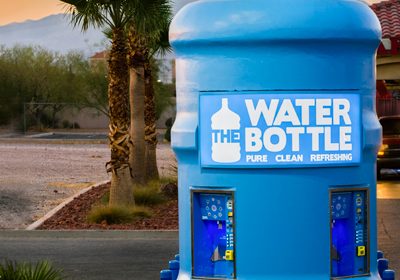When Clackamas, Ore.-based Marks Metal Technology received an inquiry about a form that would mold a giant concrete water bottle, Steve Tuttle of the company’s concrete division initially believed it was an impossible project. However, after some reflection he realized it was not only possible but would be more efficient to produce if it was created “as if it were a series of machined joint rings, stacked one on top of the other.”
Partnering with longtime customer Rockway Precast of Las Vegas, Nev., Marks Metal was able to propose a stable, 15-ft. 1-in. concrete model for The Water Bottle NV, LLC, operated by Dapper Companies. The Las Vegas developer sought a solution to which precast concrete is uniquely suited: A structure produced in easily repeatable sequences and exhibiting smooth, aesthetically pleasing surface characteristics for users seeking quality alternatives to marginal tap water.
By laminating a series of rolled heavy steel bars into manageable shapes, Marks Metal was able to create the complex exterior bottle profiles. To ensure that the required two-piece form would hold its shape under the extreme conditions of casting a large product, all of the heavy machined profiles were thermally stress relieved in a shipyard oven. This guaranteed that the form would pull apart easily and go back together without distortion. Afterwards, the steel bars were machined into a portion of the water bottle profile on a 176-in. diameter CNC vertical boring mill. When all of the precision machined pieces were finished they were stacked in the correct order to produce the many curves needed to yield a jumbo version of a typical 5-gal. drinking-water vessel.
The complex shape of the water bottle was digitized from an architect’s rendering. This exact profile was used to create the steel shapes that were directly programmed into Marks Metal’s large vertical boring mill.The inside of the form was hand blended to make sure all of the seams in the steel had minimal transfer to the concrete. According to Tuttle, “one big challenge was how to keep the vertical seams where the form splits tight so they didn’t leak and resulted in a minimal seam sign on the concrete product. There are no secrets here. This was done by expert craftsmanship on our shop floor and it turned out nearly perfect.” The blockouts for the sign, vending stations and access door were especially challenging; they required the form pieces to be modeled in Autodesk Inventor to create the complex steel patterns that would produce precisely sized openings.
Marks Metal Technology, in continuous operation since 1947, was well geared to building this type of form. Other than the thermal stress relieving, the two-piece form was made entirely in-house: the engineering, detailing, rolling, machining and fabrication. The company has over 45,000 square feet of inside production area under several overhead cranes.
